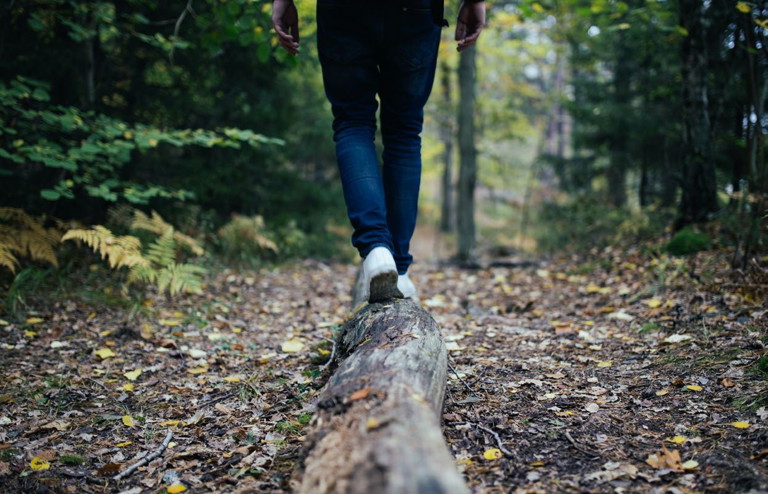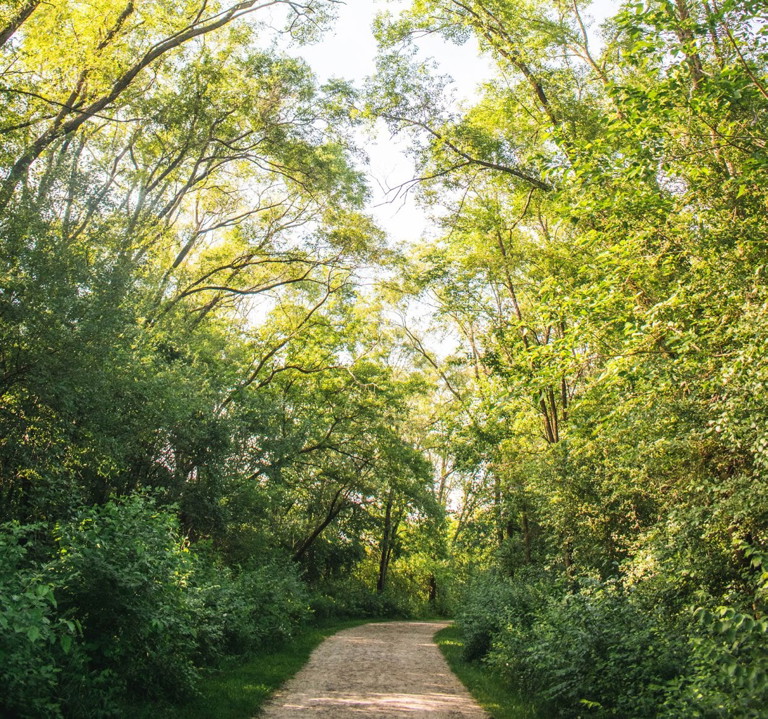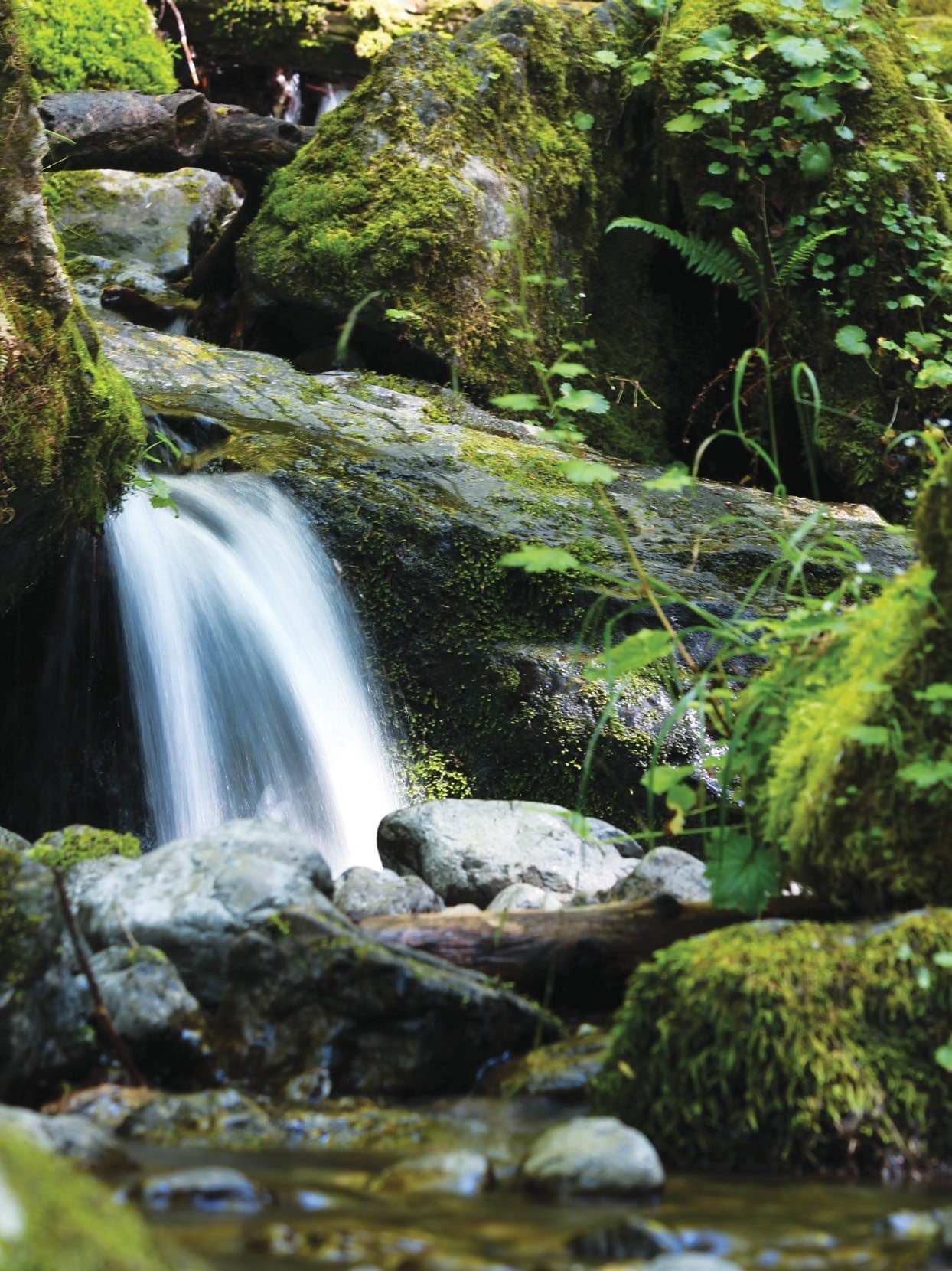ECOTHERAPY
{ PEER REVIEWED ARTICLE }
The well-evidenced benefits of ecotherapy

By Dr Geoff Berry
Australian Representative to the International Ecopsychology Society
Evidence that time spent in nature improves mental health outcomes has increased markedly over recent years. Yet for many practitioners, as well as the Australian public, the field of ecotherapy probably remains a somewhat vague idea that makes intuitive sense but hasn’t yet been clearly defined or demonstrated. With reference to landmark publications and leaders in the field, bountiful evidence of efficacy, and the core aspects of ecotherapy and its theoretical paradigm, ecopsychology, this article sets out to change that.
Ecotherapy can best be discussed as an umbrella term, according to Linda Buzzell and Craig Chalquist, the editors of the influential collection Ecotherapy: Healing with nature in mind (Buzzell & Chalquist, 2009). This volume shows that ecotherapy “represents a new form of psychotherapy that acknowledges the vital role of nature and addresses the human–nature relationship” (p. 18). From the start, then, at least two things are going on in the field of ecotherapy. Expanding psychotherapy into natural environments has been shown to offer therapeutic outcomes to individuals and groups suffering from various kinds of trauma, anxiety, grief or isolation. At the same time, as a cultural movement, ecotherapy can help to heal the rift between modern individuals and nature that has led to a broader, less defined malaise – our sense of separation and isolation from nature – that affects the wellness of most of us in some way.
In Ecotherapy: Healing with nature in mind, contributions from various authors display the extent of ecotherapeutic approaches, including walking therapy, animalassisted therapies, wilderness adventures, rites of passage and community gardens. The authors also outline the basic premise of ecotherapy, which recognises that time spent mindfully in nature reminds us that we are not separate from it. Put briefly, the biological and physical laws of nature operate in our minds, not in a reductive sense (as per the now defunct model of the body as a clockwork mechanism), but because we replicate its patterns of growth, healing and development, as well as the inevitabilities of disease and death. The patterns, codes and lessons of nature are stamped into our genetic and cultural DNA. They are inherent in the way our minds work, so that we cannot be analysed as if we operate separately from our relationship with our environment. Ecotherapy is a way of coming home, in the broadest sense, to ourselves as a part of nature. In this, it operationalises a set of concerns that were earlier taken up in ecopsychology, the theoretical framework underpinning ecotherapy. Ecopsychology had been building a knowledge base and inspiration for this research over several decades, with the 1973 publication of Arne Naess’s landmark article introducing the concept of deep ecology. However, even then, Naess and others recognised Rachel Carson’s Silent spring (1962) and, as will be shown, both the theory and practices of ecotherapy pay respects to the traditions that Indigenous peoples have lived by for millennia. But the researcher and writer who gave the field its current name was Theodore Roszak, who specifically set out to bring ecology back into psychology in The voice of the earth: An exploration of ecopsychology (1992/2001). Even as Roszak gave the discipline a solid grounding and some working definitions, at this early stage the problem of disciplinary boundaries was already recognised, with ecopsychology operating from the outset as both an extension and a critique of more conventional approaches to therapeutic outcomes. Four years after Roszak brought ecopsychology into the limelight, Clinebell did the same for ecotherapy (Clinebell, 1996). In both cases, the concept of taking therapeutic practices outdoors (or bringing the clients’ relationship with nature into the therapy room) broadened the emphasis of conventional therapeutic relationships. Including nature – defined here for brevity as the nonbuilt environment – in a one-on-one therapeutic alliance adds another voice, while also speaking to a broader cultural concern regarding our collective relationship with our environment.
Photo: Ashley Don/Unsplash
★ ★ ★
Ecotherapy has become such a widespread phenomenon in North America that time spent in nature can now be prescribed in many places, under schemes such as Park Rx (see reference list for details). In the US context, this could be seen as an efficacious response to what Richard Louv famously diagnosed as nature deficit disorder (Louv, 2005/2010). In Japan, the phenomenon of forest bathing, or shinrin-yoku as it is traditionally known, can likewise be prescribed due to decades of research into its efficacy (Hansen et al., 2017). Interestingly, this evidence indicated the extra benefits that time spent in nature offered over and above the mindfulness practice that accompanies such forest bathing and ecotherapy approaches generally (McEwan et al., 2021). Researchers attribute this increase to the higher oxygen content of forest air, as well as the possibility that the chemicals trees exude to help them fight off diseases also boost human immune systems.
Ecotherapy has been slower to take hold in Australia, partly due to the lack of training regimes. However, Australian clinical psychologist George Burns has long been recognised as a global leader in the field, since the publication of his Nature-guided therapy in 1998 (Burns, 1998/2004). Subsequent decades of research that utilised his Sensory Awareness Inventory to explore people’s pleasurable experiences confirmed for Burns that people consistently find pleasure in nature (Burns, 2009). As such, it became the basis for his therapeutic interventions for prisoners, those facing challenging relationship issues and families caught in unresolved cycles of conflict (Burns, 2009).
The Australian landscape provides excellent opportunities for shifting the focus of therapeutic practices from the clinic to ‘the great outdoors’, especially in an era when climate-related emergencies exacerbate underlying mental health issues in affected communities (Cianconi et al., 2020). The recognition that human and ecosystem health are interconnected has been heightened by current events, including increased incidences and severity of fires, floods and pandemics. Recent shifts in the field reflect this growing concern, with cases of eco-anxiety and ecological grief becoming noticeable in communities affected by climate change (Clayton et al., 2017; Cunsolo & Ellis, 2018; Hayes & Poland, 2018). Cunsolo et al. (2020) suggest that mental health responses to these increasing crises should include increased training for health professionals on the ways climate change can affect mental health, harnessing proven individual and group therapy strategies, including a family focus and ensuring health equity.
Even in our urbanised capital cities, accessibility to nature does not need to become a barrier to the practice, as contemporary practices include indoor and urban ecotherapies (using memories to recall moments of special connection with nature, images and objects to reflect upon, or even a view out of a window). What is important for practitioners who wish to incorporate ecotherapy into their practice is that they are trained to expect what incorporating nature into a therapeutic paradigm can mean, including the wide variety of potentials and pitfalls expected within such a broadly defined discipline.

Photo: Jon Flobrant/Unsplash
In general, ecotherapy and its theoretical framework ecopsychology draw upon three main areas of inspiration:
■ They integrate mindfulness practices, asking not only that we ‘breathe in’ the natural world and its healing benefits, but that we practise awareness of how we feel before and after such exercises.
■ They take seriously what can be learnt from Indigenous epistemologies, in particular the sense of kinship and belonging that dissolve the existential dilemma of separation from nature and each other that is such a common aspect of modern life.
■ They reference the depth psychologies of myth, symbol and the stories we identify with, which often distance us from a true sense of communing with nature and its healing powers.
Mindfulness aspects often draw from Buddhist approaches, and the intersection of mindfulness and ecotherapy is thoroughly summarised in Caroline Brazier’s Ecotherapy in practice (2017). Mindfulness has of course become a widely referenced paradigm in wellness discourse, since Western practitioners such as Jon Kabat-Zinn showed the scientific basis of its efficacy in stress reduction. In ecotherapy, a typical mindfulness practice would extend the classic calming method of breath awareness to becoming more aware of how we are actually at home in nature and what we can learn when we awaken to its healing properties. Mindfulness practices in ecotherapy also commonly include a gratitude practice and are designed to be simple, safe ways of supporting clients to do their own work and chart their own results.
In terms of Indigenous wisdom, Australians are fortunate to share the presence, and teachings, of the oldest living culture on the planet and their traditions of ‘care for Country’. Teachers such as Miriam Rose Ungunmerr Baumann, 2021 Senior Australian of the year, have long advocated that modern Australians practise an Aboriginal mindfulness practice known as Dadirri. Ungunmerr Baumann describes this Aboriginal practice as an “inner, deep listening and quiet, still awareness” that makes people feel “whole again” because it reminds us that the “deep spring” of nature is within as well as around us at all times (Ungunmerr Baumann, 1988). This ancient form of wellness must be seen as a valuable complement to the scientific evidence that forms of ecotherapy can benefit all people. Ungunmerr Baumann’s teaching of Dadirri ‘re-places’ the individual in a broader ecosystem that is alive with meaning. It also accords with an existentialist approach and with mindfulness practices, where we are guided to bring our attention back to what arises in the moment, to focus on what is real or alive for us and not to suppress our inner conflicts or emotional upsets.

Photo: Jonnelle Yankovich/Unsplash
The concerns of depth psychology may be summarised, for brevity’s sake, as a person’s level of connection to and awareness of the patterns that inform them from beyond their personal history. The myths that guide the way we are socialised – into a society ruled by profitability and economic growth, for instance – need to be taken into account as a collective story that very often influences us to accept less satisfying, even soulless versions of ourselves. Paul Shepard’s Nature and madness (1982) remains influential in ecotherapy literature for having shown the cost of modernity’s shift away from rites of passage, which commonly initiated adults into a reciprocal relationship with their local ecosystem. While the processes of initiation into nature connection are rarely part of modern socialisation processes, we can tap into these deep stories and their therapeutic qualities when given the opportunity to do so. The natural world around us is filled with metaphors that help us to see our connection to patterns of growth and healing (for example, watching grass spring back after being trodden on), flow and ease (such as the path of a river as it winds around obstacles) and so on. Arne Naess may even have shifted the conversation from depth to breadth psychology when he coined the term ‘deep ecology’. Naess showed how we can find our way back to identification with nature, as a form of ‘ecological self’, which expands our commonly individualistic sense of self (Naess, 1995).
One core exercise utilised in ecotherapy programs worldwide shows how these three paradigms can be usefully integrated to benefit mental health outcomes. This exercise is the Sit Spot, which requires a person to sit in the same place over time, for a certain period each day or week, and notice whatever arises there. (This article focuses on ecotherapy for adults; the relationship would change when working with children, especially those who have suffered trauma.) Participants routinely report growing awareness of the beautiful intricacy of nature all around them, in small things such as the way ants rebuild a nest, to changing seasons bringing new growth after winter. Finding metaphors for healing and growth is a common result from the Sit Spot exercise, while journaling the experience offers participants the opportunity to reflect on their place in the ecosystem, especially when they are guided by an ecotherapist to find ways to enhance a sense of belonging in their lives, bodies and place. In such ways, a combination of awareness paradigms and traditional practices can help individuals to realise that their identity, or story of themselves, can become integrated within a broader ecosystem (or bigger picture).

★ ★ ★
While it is incumbent upon any ecotherapy training regime to incorporate aspects of these three great traditions, the evidence supporting the efficacy of nature healing modalities is also built upon sound scientific research. Landmark evidence from almost 40 years ago suggested that patients who could look out on natural scenery, as opposed to those who faced brick walls, enjoyed improved outcomes after serious surgery, including earlier release, fewer negative evaluative notes from nurses and less need for potent analgesics (Ulrich, 1984). Concrete examples of the restorative effects available to those immobilised in a built environment have also been attested after similar research in prisons, with reduced demand for healthcare services following mindful gardening programs (Moore, 1981; Lee et al., 2021). Community garden work, featuring an ecotherapeutic approach that combines mindful socialising with sowing, weeding and harvesting opportunities through the seasons, has been a significant platform of Mind, a major mental health organisation in the United Kingdom, since 2007. Horticulture therapies have been shown to be effective in treating symptoms and improving rehabilitation outcomes, quality of life and social functioning in patients with schizophrenia (Lu et al., 2021). They have also been shown to reduce apathy and promote cognitive function in nursing home residents with dementia, which is important in an increasingly ageing society (Yang et al., 2022).
The fact that time spent with exposure to nature improves mental health outcomes stands regardless of whether we are considering those limited to very closed environments (for example, prisons, hospitals or nursing homes) or more generally (such as those living in urban centres). Research shows that spending time in nature generally improves a broad set of mental health issues and symptoms (Hunyh et al., 2022; Summers & Vivian, 2018), while there is also evidence of the mental health benefits of exercising outdoors as opposed to in gyms (Pretty et al., 2005). On a global scale, increased international cooperation has helped provide more specific scientific verification that spending time in natural settings is good for mental health, with results being replicated (with some variance) across countries (White et al., 2021). When associations between spaces that have become known as ‘green’ (for example, those that are inland, forested, gardened or flourishing) and ‘blue’ (such as with coastal or other water views) were examined in mental health research across 18 European countries, correlations were clear. Researchers showed that frequency of recreational visits to natural spaces in the previous four weeks were all positively associated with wellbeing, less experience of mental distress and a lower likelihood of using medication for depression. This substantiates earlier longitudinal studies, which found that people who moved to greener areas experienced an immediate improvement in mental health that was sustained for at least three years after they moved (Alcock et al., 2014).
A social equity question naturally followed such outcomes; perhaps these results revealed a socioeconomic aspect, which made them unattainable for those without the lifestyle benefits of being richer, healthier and thus able to afford to spend time in nicer places (Dolan, 2021)? Thankfully, this potential inequality was found to be almost reversed, when proximity to the coastline was shown to have a higher correlation with better mental health amongst more deprived groups (Garrett et al., 2019). Time spent in nature seems to be healing even without the benefit of ecotherapeutic interventions.
Meanwhile, Cooley et al. (2020) point out that while reduced stress responses and improved mood have been clearly shown as physiological and psychological benefits of time spent in nature, talk therapies are specifically “enriched by added mutuality, freedom of expression, mind–body holism, interconnectedness with the natural world, and practitioner wellbeing” (p. 1). This added value was noted regardless of the extent to which the therapy incorporated the environment – the therapeutic alliance could actively utilise nature or it could remain a passive backdrop, regardless of whether the experience took place in urban parks or wilderness areas. Cooley et al. also discuss how safety and professional competency need to be taken into account when ecotherapy sessions take place in the less predictable spaces out of doors. The specific challenges facing ecotherapy in this respect are also discussed by Patricia Hasbach in Prescribing nature: Techniques, challenges and ethical considerations (Hasbach, 2016).
Psychologists warn that the impact of climate change “can be debilitating for the growing number of people overwhelmed by the scientific reality of ecological breakdown and for those who have lived through traumatic climate events” (Taylor & Murray, 2020). In this context, ACA has made a commitment to ‘future-proofing’ the counselling profession by recognising that the “counselling and psychotherapy profession have an important role to play in addressing mental health issues in relation to climate change and post-disasters” (ACA, 2021). The ACA Climate Change Commitment is appropriate and agile, stating that:
moving forward, we strongly recommend that counsellors and psychotherapists acquire specialist skills and knowledge to assist in providing effective culturally responsive counselling and psychotherapy for work related to climate change and post-disasters. In addition, it is vital to understand the importance of social justice advocacy as an important aspect of the counselling and psychotherapy work.
This remit can be developed with regards to ecotherapy, as a fast-evolving approach to mental health that takes into account freely available benefits, in both crisis and everyday contexts, in a time of increasing ecosystem breakdown. Ecotherapeutic approaches, from community gardening or habitat rehabilitation projects to walking therapy outdoors, are increasingly being incorporated into programs designed to help ease eco-anxiety in climate scientists, researchers and even parents who do not know how to talk to their children about climate change in their futures (Taylor & Murray, 2020). Learning to work more effectively with young people will become even more important as they are increasingly impacted by the ongoing effects of climate change.
★ ★ ★
By following the robust definitions and strategies that are part of the nascent field of ecopsychology, and by including traditional practices such as mindful awareness and openness to an innate sense of belonging in nature, an ecotherapist with requisite experience can guide clients to the sense of ease and other mental health benefits that have long been suggested by such practices. Well-researched evidence continues to support this suggestion. What is required in an ecotherapist is the same as what we would expect from any personcentred counsellor; someone who has ‘done the work’, is deeply connected with the healing powers of nature and can thereby help others to do the same. Ironically, for therapist and client alike, this may often seem more like a process of ‘unlearning’ tendencies that keep so many modern individuals from experiencing a healthy relationship with their environment. Ecotherapists the world over prescribe ‘homework’, much as a cognitive behavioural therapy practitioner would; only this prescription is more likely to be an invitation to inhabit our lives – our bodies and minds, our place and community – with an attitude of deep listening and expanded awareness. The therapeutic aims are also similar; to enable people to experience greater agency, relief from anxiety (whether it be generalised or specific, for example about an increasingly unstable future) and a path out of depressive states or addictive tendencies, and to promote healing and limit suffering in any life stage or process. ■
The author acknowledges a conflict of interest as presenter of the Advanced Certificate in Ecotherapy training course.
References
Alcock, I., White, M., Wheeler, B., Fleming, L., & Depledge, M. (2014). Longitudinal effects on mental health of moving to greener and less green urban areas. Environ. Sci. Technol, 48(2), 1247–1255. doi.org/10.1021/es403688w
ACA. (2021). Statement of commitment on climate change. Climate_ Change_Commitment_ Australian_Counselling_Association_02052021.pdf
Bratman, G., & Olvera-Alvarez, H. (2022). Special issue on nature and health: Perspectives and pathways [Editorial]. Ecopsychology, 14(3), 133–136. http://doi.org/10.1089/ eco.2022.29007.editorial
Brazier, C. (2017). Ecotherapy in practice. Taylor & Francis.
Burns, G. (1998/2014). Nature-guided therapy: Brief integrative strategies for health and wellbeing. Brunner/ Mazel.
Burns, G. (2009). The path of happiness: Integrating nature into therapy for couples and families. In L. Buzzell, & C. Chalquist (Eds.), Ecotherapy: Healing with nature in mind. Sierra Club Books.
Buzzell, L. (2016). The many ecotherapies. In M. Jordan, & J. Hinds (Eds.), Ecotherapy: Theory, research and practice. Bloomsbury.
Buzzell, L., & Chalquist, C. (2009). Ecotherapy: Healing with nature in mind. Sierra Club Books.
Chaudhury, P., & Banerjee, D. (2020). “Recovering with nature”: A review of ecotherapy and implications for the
COVID-19 pandemic. Front. Public Health, 8, 604440. doi:10.3389/fpubh.2020.604440
Cianconi, P., Betrò, S., & Janiri, L. (2020). The impact of climate change on mental health: A systematic descriptive review. Front. Psychiatry, Sec. Public Mental Health, 11. doi.org/10.3389/fpsyt.2020.00074
Clayton, S., Manning, C., Krygsman, K., & Speiser, M. (2017). Mental health and our changing climate: Impacts, implications, and guidance.
American Psychological Association. www.apa.org/news/press/releases/2017/03/mentalhealth-climate.pdf
Clinebell, H. (1996). Ecotherapy: Healing ourselves, healing the earth. Fortress Press.
Cooley, S., Jones, C., Kurtz, A., & Robertson, N. (2020). “Into the wild”: A meta-synthesis of talking therapy in natural outdoor spaces. Clinical Psychology Review, 77. DOI: 10.1016/j.cpr.2020.101841
Cunsolo, A., & Ellis, N. (2018). Ecological grief as a mental health response to climate change-related loss. Nat Clim Change 8, 275–281.
Cunsolo, A., Harper, S. L., Minor, K., Hayes, K., Williams, K. G., & Howard, C. (2020). Ecological grief and anxiety: The start of a healthy response to climate change? The Lancet Planetary Health, 4(7), e261–e263. doi.org/10.1016/S2542-5196(20)30144-3
Dolan, E. (2021). Frequent visits to nature linked to enhanced psychological well-being and reduced mental distress. PsyPost. psypost.org/2021/06/frequent-visits-to-naturelinked-to-enhancedpsychological-well-beingand-reduced-mentaldistress-61142
Garrett, J., Clitherow, T., White. M., Wheeler, B., & Fleming, L. (2019). Coastal proximity and mental health among urban adults in England: The moderating effect of household income. Health & Place, 59. doi.org/10.1016/j.healthplace.2019.102200
Georgiou, M., Morison, G., Smith, N., Tieges, Z., & Chastin, S. (2021). Mechanisms of impact of blue spaces on human health: A systematic literature review and meta-analysis.
International Journal of Environmental Research and Public Health 18(5), 2486. doi.org/10.3390/ ijerph18052486
Hansen, M., Jones, R., & Tocchini, K. (2017). Shinrin-yoku (forest bathing) and nature therapy: A state-of-theart review. Int J Environ Res Public Health, 14(8), 851. doi:10.3390/ijerph14080851
Hasbach, P. (2016). Prescribing nature: Techniques, challenges and ethical considerations. In M. Jordan, & J. Hinds (Eds.), Ecotherapy: Theory, research and practice. Bloomsbury.
Hayes, K., & Poland, B. (2018). Addressing mental health in a changing climate: Incorporating mental health indicators into climate change and health vulnerability and adaptation assessments. Int J Environ Res Public Health, 15, 1806.
Huynh, L. T. M., Gasparatos, A., Su, J., Dam Lam, R., Grant, E. I., and Fukushi, K. ‘Linking the nonmaterial dimensions of humannature relations and human well-being through cultural ecosystem services’, Sci. Adv., 8(31), p. eabn8042, Aug. 2022, doi:10.1126/sciadv.abn8042
Jordan, M., & Hinds, J. (2016). Ecotherapy: Theory, research and practice. Bloomsbury.
Lee, A., Kim, S., Kwon, H. J., & Park, S. (2021). Horticultural therapy program for mental health of prisoners: Case report. Integrative Medicine Research, 10(2), 100495–100498. doi.org/10.1016/j.imr.2020.100495
Louv, R. (2005/2010). Last child in the woods: Saving our children from nature-deficit disorder. Atlantic Books.
Louv, R. (2011). The nature principle: Human restoration and the end of nature-deficit disorder. Algonquin Books.
Lu, S., Zhao, Y., Liu, J., Xu, F., & Wang, Z. (2021). Effectiveness of horticultural therapy in people with schizophrenia: A systematic review and meta-analysis. Int. J. Environ. Res. Public Health, 18, 964. doi.org/10.3390/ijerph18030964
McEwan, K., Giles, D., Clarke, F. J., Kotera, Y., Evans, G., Terebenina, O., Minou, L., Teeling, C., Basran, J., Wood, W., & Weil, D. (2021). A pragmatic controlled trial of forest bathing compared with compassionate mind training in the UK: Impacts on self-reported wellbeing and heart rate variability. Sustainability, 13(3), 1380. https://doi.org/10.3390/su13031380
Mind UK. (2013). Ecotherapy works. www.mind.org.uk/informationsupport/your-stories/ecotherapy-works
Moore, E. O. (1981). A prison environment’s effect on health care service and demands. Journal of Environmental Systems, 11(1), 17–34.
Naess, A. (1973). The shallow and the deep, long-range ecology movement: A summary. Inquiry, 16 (1–4), 95–100. doi:10.1080/00201747308601682
Naess, A. (1995). Selfrealization. An ecological approach to being in the world. In G. Sessions (Ed.), Deep ecology for the twenty-first century (pp. 225–239). Shambhala.
Park Rx America. (n.d.). Park Rx America. parkrxamerica.org
Parx Canada. (n.d.). A prescription for nature. www.parkprescriptions.ca
Pretty, J., Peacock, J., Sellens, M., & Griffin, M. (2005). The mental and physical health outcomes of green exercise.
International Journal of Environmental Health Research, 15, 319–337.
Roszak, T. (1992/2001). The voice of the earth: An exploration of ecopsychology. Phanes Press, Inc.
Shepard, P. (1982). Nature and madness. University of Georgia Press.
Summers, J., & Vivian, D. (2018). Ecotherapy – A forgotten ecosystem service: A review.
Front. Psychol., 9,1389. doi:10.3389/fpsyg.2018.01389
Taylor, M., & Murray, J. (2020). “Overwhelming and terrifying”: The rise of climate anxiety. The Guardian. theguardian.com/environment/2020/feb/10/overwhelmingand-terrifying-impact-ofclimate-crisis-on-mentalhealth
Ulrich, R. S. (1984). View through a window may influence recovery from surgery. Science, 224, 420–421.
Ungunmerr Baumann, M. (1988). Inner deep listening and quiet still awareness. Mirriam Rose Foundation. miriamrosefoundation.org.au/dadirri
White, M. P., Elliott, L. R., & Grellier, J. (2021). Associations between green/blue spaces and mental health across 18 countries. Sci Rep, 11, 8903. doi.org/10.1038/s41598-021-87675-0
Yang, Y., Kwan, R. Y. C., Zhai, H.-M., Xiong, Y., Zhao, T., Fang, K.-L., & Zhang, H.-Q. (2022). Effect of horticultural therapy on apathy in nursing home residents with dementia: A pilot randomized controlled trial. Aging & Mental Health, 26(4), 745–753. DOI: 10.1080/ 13607863.2021.1907304
ADVERTISEMENT
